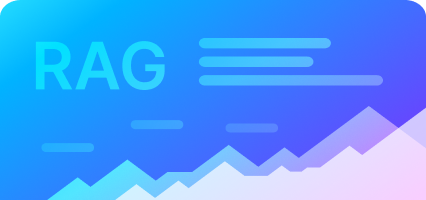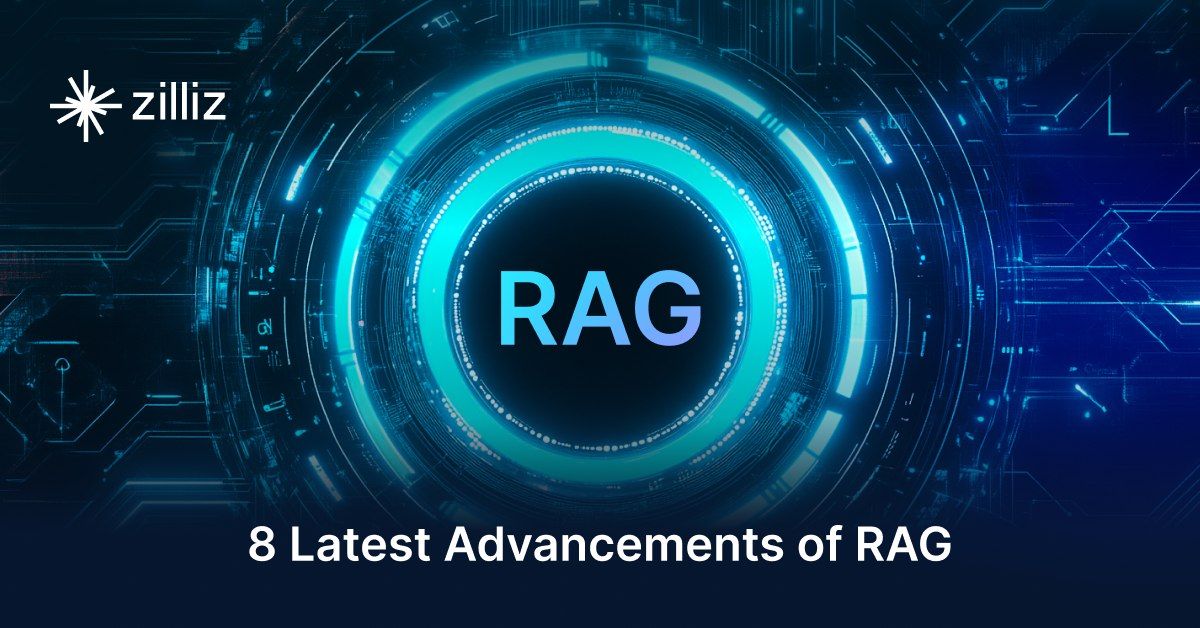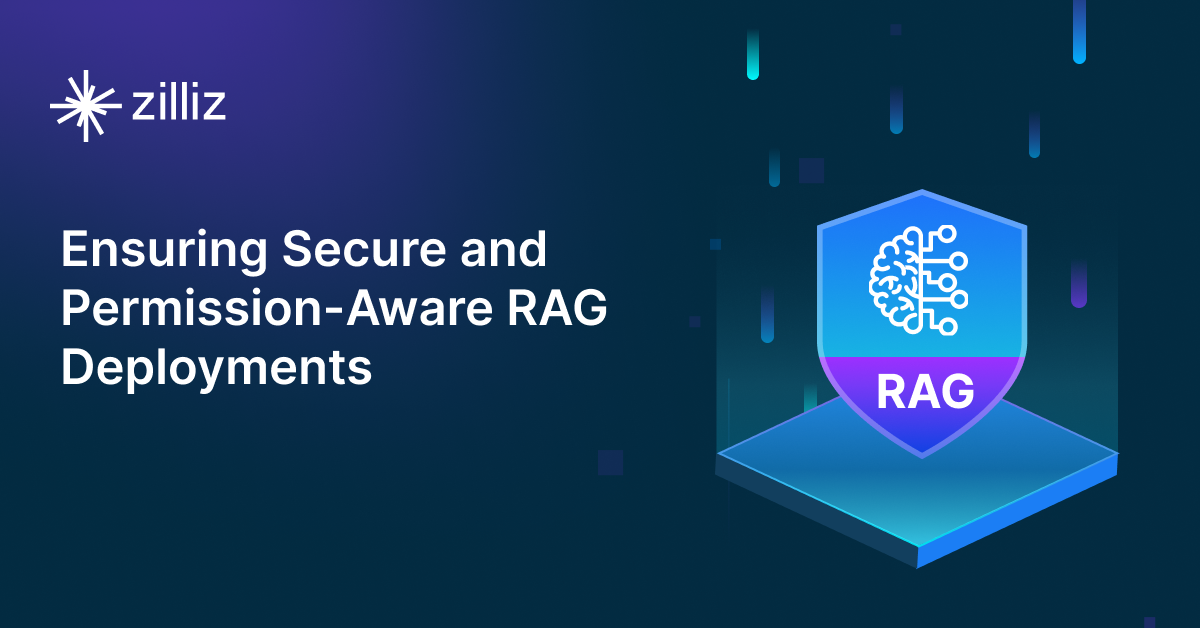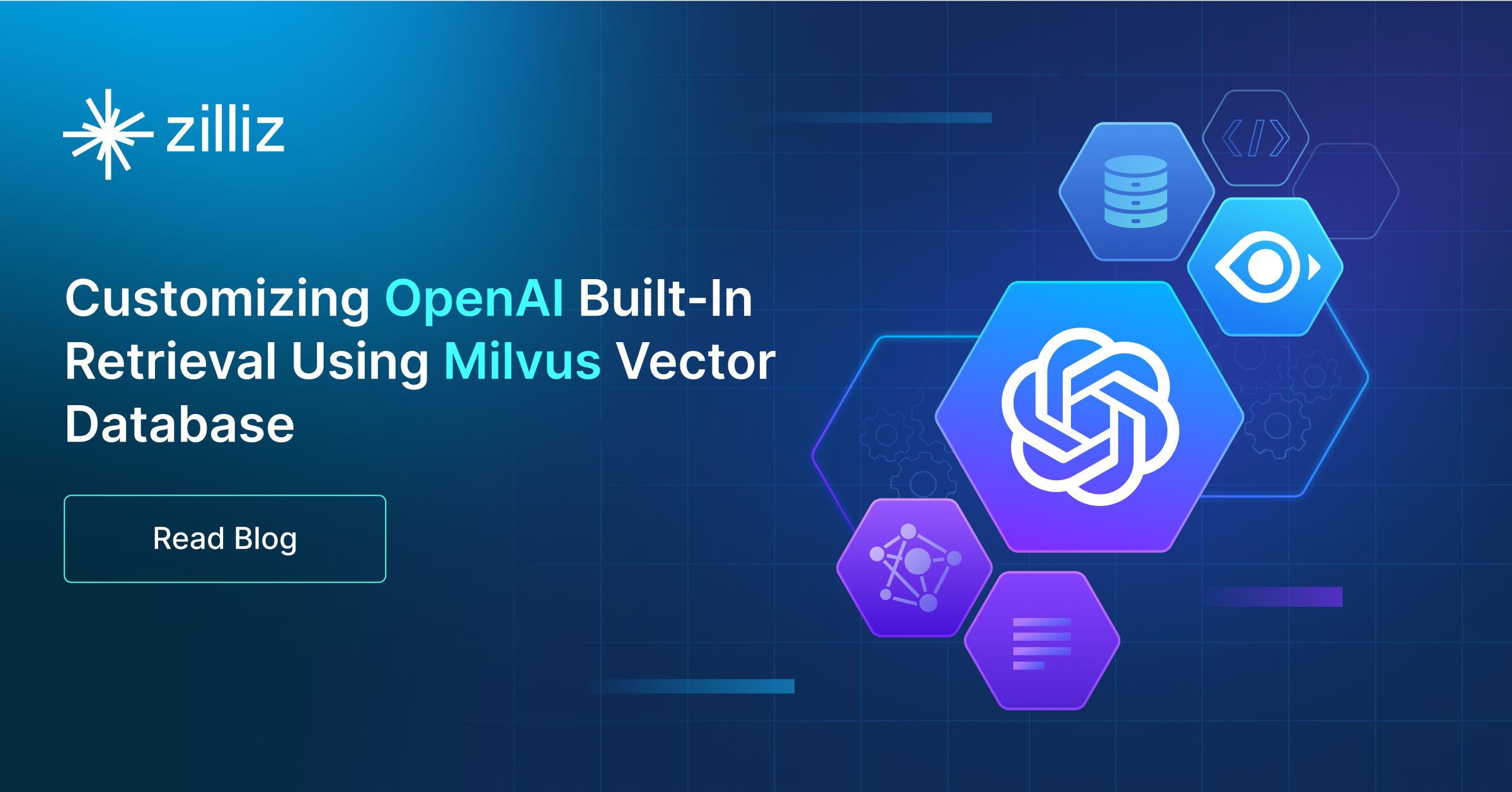Build RAG Chatbot with LangChain, Milvus, Groq llama3-70b-8192, and Ollama nomic-embed-text
Introduction to RAG
Retrieval-Augmented Generation (RAG) is a game-changer for GenAI applications, especially in conversational AI. It combines the power of pre-trained large language models (LLMs) like OpenAI’s GPT with external knowledge sources stored in vector databases such as Milvus and Zilliz Cloud, allowing for more accurate, contextually relevant, and up-to-date response generation. A RAG pipeline usually consists of four basic components: a vector database, an embedding model, an LLM, and a framework.
Key Components We'll Use for This RAG Chatbot
This tutorial shows you how to build a simple RAG chatbot in Python using the following components:
- LangChain: An open-source framework that helps you orchestrate the interaction between LLMs, vector stores, embedding models, etc, making it easier to integrate a RAG pipeline.
- Milvus: An open-source vector database optimized to store, index, and search large-scale vector embeddings efficiently, perfect for use cases like RAG, semantic search, and recommender systems. If you hate to manage your own infrastructure, we recommend using Zilliz Cloud, which is a fully managed vector database service built on Milvus and offers a free tier supporting up to 1 million vectors.
- Groq llama3-70b-8192: The llama3-70b-8192 model is a large language model developed by Meta, featuring 70 billion parameters and an 8,192-token context window. This model is designed for general-purpose language tasks, including text generation, summarization, and translation. Groq, a company specializing in AI hardware and software solutions, offers the llama3-70b-8192 model through its API. This integration allows developers to leverage Groq's high-performance Language Processing Unit (LPU) for efficient inference. Groq's LPU is known for its deterministic, single-core streaming architecture, which provides predictable and repeatable performance for AI workloads.
- Ollama nomic-embed-text: This model specializes in generating high-quality text embeddings, designed to enhance semantic understanding in various NLP tasks. Its strengths lie in contextual representation and scalability, making it suitable for applications like semantic search, recommendation systems, and clustering. Ideal for developers looking to integrate profound text analysis into their projects.
By the end of this tutorial, you’ll have a functional chatbot capable of answering questions based on a custom knowledge base.
Note: Since we may use proprietary models in our tutorials, make sure you have the required API key beforehand.
Step 1: Install and Set Up LangChain
%pip install --quiet --upgrade langchain-text-splitters langchain-community langgraph
Step 2: Install and Set Up Groq llama3-70b-8192
pip install -qU "langchain[groq]"
import getpass
import os
if not os.environ.get("GROQ_API_KEY"):
os.environ["GROQ_API_KEY"] = getpass.getpass("Enter API key for Groq: ")
from langchain.chat_models import init_chat_model
llm = init_chat_model("llama3-8b-8192", model_provider="groq")
Step 3: Install and Set Up Ollama nomic-embed-text
pip install -qU langchain-ollama
from langchain_ollama import OllamaEmbeddings
embeddings = OllamaEmbeddings(model="nomic-embed-text")
Step 4: Install and Set Up Milvus
pip install -qU langchain-milvus
from langchain_milvus import Milvus
vector_store = Milvus(embedding_function=embeddings)
Step 5: Build a RAG Chatbot
Now that you’ve set up all components, let’s start to build a simple chatbot. We’ll use the Milvus introduction doc as a private knowledge base. You can replace it with your own dataset to customize your RAG chatbot.
import bs4
from langchain import hub
from langchain_community.document_loaders import WebBaseLoader
from langchain_core.documents import Document
from langchain_text_splitters import RecursiveCharacterTextSplitter
from langgraph.graph import START, StateGraph
from typing_extensions import List, TypedDict
# Load and chunk contents of the blog
loader = WebBaseLoader(
web_paths=("https://milvus.io/docs/overview.md",),
bs_kwargs=dict(
parse_only=bs4.SoupStrainer(
class_=("doc-style doc-post-content")
)
),
)
docs = loader.load()
text_splitter = RecursiveCharacterTextSplitter(chunk_size=1000, chunk_overlap=200)
all_splits = text_splitter.split_documents(docs)
# Index chunks
_ = vector_store.add_documents(documents=all_splits)
# Define prompt for question-answering
prompt = hub.pull("rlm/rag-prompt")
# Define state for application
class State(TypedDict):
question: str
context: List[Document]
answer: str
# Define application steps
def retrieve(state: State):
retrieved_docs = vector_store.similarity_search(state["question"])
return {"context": retrieved_docs}
def generate(state: State):
docs_content = "\n\n".join(doc.page_content for doc in state["context"])
messages = prompt.invoke({"question": state["question"], "context": docs_content})
response = llm.invoke(messages)
return {"answer": response.content}
# Compile application and test
graph_builder = StateGraph(State).add_sequence([retrieve, generate])
graph_builder.add_edge(START, "retrieve")
graph = graph_builder.compile()
Test the Chatbot
Yeah! You've built your own chatbot. Let's ask the chatbot a question.
response = graph.invoke({"question": "What data types does Milvus support?"})
print(response["answer"])
Example Output
Milvus supports various data types including sparse vectors, binary vectors, JSON, and arrays. Additionally, it handles common numerical and character types, making it versatile for different data modeling needs. This allows users to manage unstructured or multi-modal data efficiently.
Optimization Tips
As you build your RAG system, optimization is key to ensuring peak performance and efficiency. While setting up the components is an essential first step, fine-tuning each one will help you create a solution that works even better and scales seamlessly. In this section, we’ll share some practical tips for optimizing all these components, giving you the edge to build smarter, faster, and more responsive RAG applications.
LangChain optimization tips
To optimize LangChain, focus on minimizing redundant operations in your workflow by structuring your chains and agents efficiently. Use caching to avoid repeated computations, speeding up your system, and experiment with modular design to ensure that components like models or databases can be easily swapped out. This will provide both flexibility and efficiency, allowing you to quickly scale your system without unnecessary delays or complications.
Milvus optimization tips
Milvus serves as a highly efficient vector database, critical for retrieval tasks in a RAG system. To optimize its performance, ensure that indexes are properly built to balance speed and accuracy; consider utilizing HNSW (Hierarchical Navigable Small World) for efficient nearest neighbor search where response time is crucial. Partitioning data based on usage patterns can enhance query performance and reduce load times, enabling better scalability. Regularly monitor and adjust cache settings based on query frequency to avoid latency during data retrieval. Employ batch processing for vector insertions, which can minimize database lock contention and enhance overall throughput. Additionally, fine-tune the model parameters by experimenting with the dimensionality of the vectors; higher dimensions can improve retrieval accuracy but may increase search time, necessitating a balance tailored to your specific use case and hardware infrastructure.
Groq llama3-70b-8192 optimization tips
To optimize Groq llama3-70b-8192 in a Retrieval-Augmented Generation (RAG) system, focus on efficient batch processing to maximize throughput by grouping multiple requests together. Utilize mixed precision for faster computation while maintaining model accuracy, and adjust input sequence length to strike a balance between context richness and computational efficiency. Leverage model parallelism to distribute workloads across multiple processing units, ensuring scalability. Regularly monitor GPU utilization and ensure that memory is efficiently managed by freeing unused tensors to prevent bottlenecks. Fine-tune the model on specific tasks or domains to improve accuracy and reduce inference time. Additionally, consider pruning or quantizing certain layers to optimize performance for production-level tasks without compromising too much on model output quality.
Ollama nomic-embed-text optimization tips
Ollama nomic-embed-text is designed for robust text embedding generation, making it essential to optimize how embeddings are stored and queried in a RAG pipeline. Preprocess input text by stripping unnecessary metadata and normalizing case to maintain consistency. Choose an optimized vector indexing strategy, such as IVF-PQ for balanced speed and accuracy, depending on dataset size. Use approximate nearest neighbor search to accelerate retrieval while maintaining a high recall rate. Cache commonly accessed embeddings to avoid redundant computations. If embeddings are used for long-term retrieval tasks, periodically refresh and retrain on new data to prevent model drift. Optimize database queries to quickly retrieve relevant embeddings and minimize I/O bottlenecks.
By implementing these tips across your components, you'll be able to enhance the performance and functionality of your RAG system, ensuring it’s optimized for both speed and accuracy. Keep testing, iterating, and refining your setup to stay ahead in the ever-evolving world of AI development.
RAG Cost Calculator: A Free Tool to Calculate Your Cost in Seconds
Estimating the cost of a Retrieval-Augmented Generation (RAG) pipeline involves analyzing expenses across vector storage, compute resources, and API usage. Key cost drivers include vector database queries, embedding generation, and LLM inference.
RAG Cost Calculator is a free tool that quickly estimates the cost of building a RAG pipeline, including chunking, embedding, vector storage/search, and LLM generation. It also helps you identify cost-saving opportunities and achieve up to 10x cost reduction on vector databases with the serverless option.
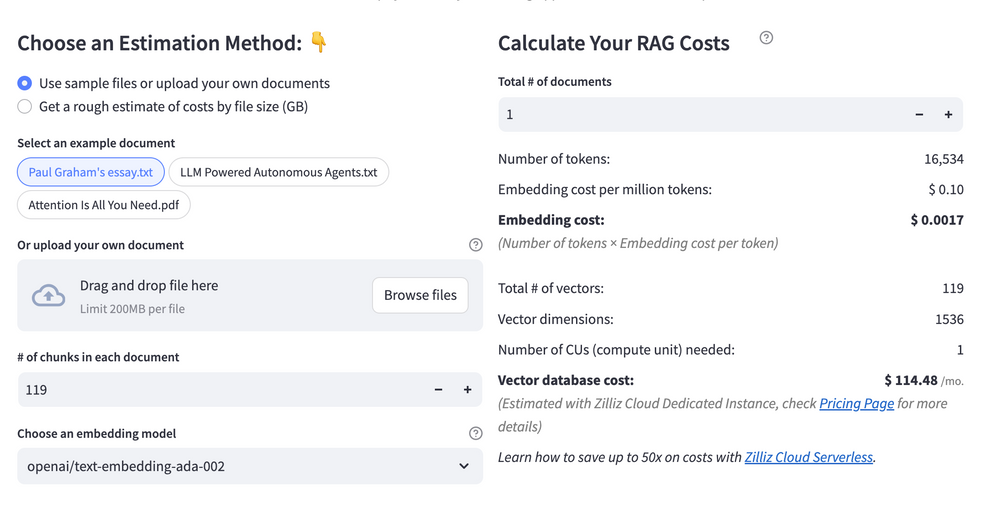 Calculate your RAG cost
Calculate your RAG cost
What Have You Learned?
By now, you’ve unlocked the power of combining cutting-edge tools to build a fully functional RAG system! You learned how LangChain acts as the glue, orchestrating workflows between components like a maestro. It seamlessly connects your data pipeline to Milvus, a blazing-fast vector database that stores and retrieves embeddings with precision. Speaking of embeddings, Ollama’s nomic-embed-text model transformed your raw text into rich numerical representations, capturing semantic meaning in ways that make retrieval meaningful. And then there’s Groq’s llama3-70b-8192—a powerhouse LLM that generates human-like responses at lightning speed, turning retrieved context into coherent, actionable answers. Together, these tools form a dynamic pipeline where each piece plays a critical role: embedding models encode knowledge, vector databases organize it, frameworks like LangChain streamline the flow, and LLMs bring it all to life. You’ve also picked up pro tips for optimizing performance, like tuning chunk sizes and experimenting with retrieval strategies, and even discovered how to estimate costs with a free RAG cost calculator—ensuring your projects stay efficient and scalable.
But this is just the beginning! You’ve got the blueprint to create intelligent applications that answer questions, summarize content, or even power chatbots with context-aware superpowers. The tools are in your hands, and the possibilities are endless. Imagine building custom knowledge assistants, enhancing customer support, or unlocking insights from massive datasets—all while keeping costs in check and performance sky-high. So what are you waiting for? Tweak those parameters, experiment with hybrid search strategies, and let your creativity run wild. The RAG ecosystem is evolving fast, and you’re now part of the wave shaping its future. Start building, iterate fearlessly, and share what you create—the world needs your innovative solutions. Go make something awesome! 🚀
Further Resources
🌟 In addition to this RAG tutorial, unleash your full potential with these incredible resources to level up your RAG skills.
- How to Build a Multimodal RAG | Documentation
- How to Enhance the Performance of Your RAG Pipeline
- Graph RAG with Milvus | Documentation
- How to Evaluate RAG Applications - Zilliz Learn
- Generative AI Resource Hub | Zilliz
We'd Love to Hear What You Think!
We’d love to hear your thoughts! 🌟 Leave your questions or comments below or join our vibrant Milvus Discord community to share your experiences, ask questions, or connect with thousands of AI enthusiasts. Your journey matters to us!
If you like this tutorial, show your support by giving our Milvus GitHub repo a star ⭐—it means the world to us and inspires us to keep creating! 💖
- Introduction to RAG
- Key Components We'll Use for This RAG Chatbot
- Step 1: Install and Set Up LangChain
- Step 2: Install and Set Up Groq llama3-70b-8192
- Step 3: Install and Set Up Ollama nomic-embed-text
- Step 4: Install and Set Up Milvus
- Step 5: Build a RAG Chatbot
- Optimization Tips
- RAG Cost Calculator: A Free Tool to Calculate Your Cost in Seconds
- What Have You Learned?
- Further Resources
- We'd Love to Hear What You Think!
Content
Vector Database at Scale
Zilliz Cloud is a fully-managed vector database built for scale, perfect for your RAG apps.
Try Zilliz Cloud for Free